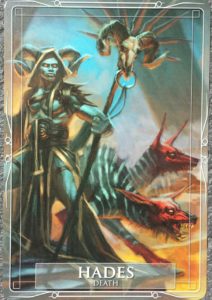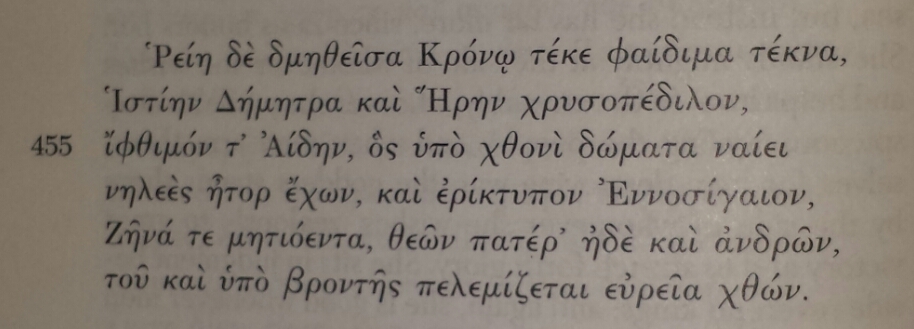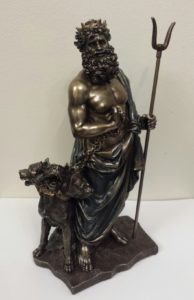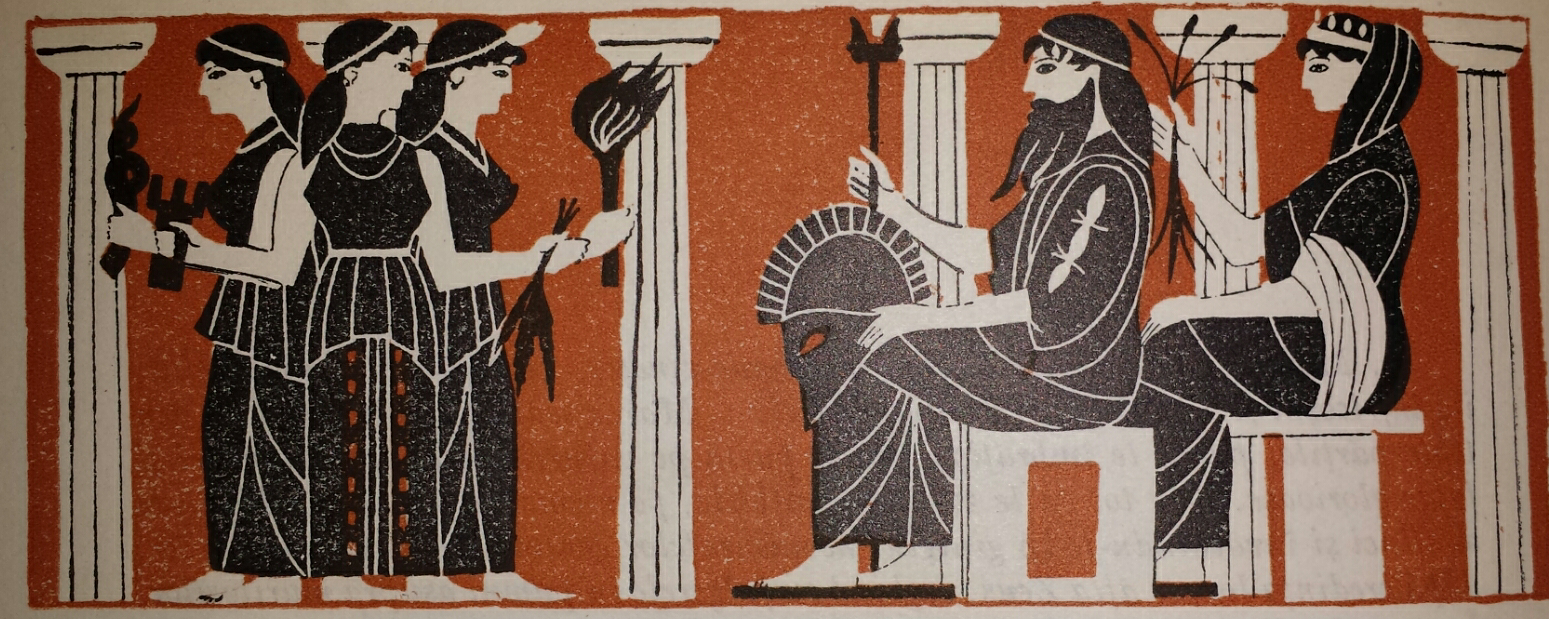Hades was the Greek god of the Underworld who is sometimes misrepresented as the God of Death. Although he was seen as a fertility god by the ancient Greeks, pop culture references often depict him as an evil or fearsome character. However, readings of ancient Greek texts suggest that he was a more considerate and personable character than we have been led to believe. In this blog post, we will explore Hades’ family tree, dominion, personality and worship.
Origins and pedigree
According to the Olympian creation myth, the Titans Cronos and Rhea had six children: Hestia, Demeter, Hera, Hades, Poseidon and Zeus (Apollodorus n.d.). The Parents of the Titans were the Earth Mother (Gaia) and the Sky Father (Uranus) and they foretold that one of Cronos’s children would usurp him (Roman and Roman 2010). Determined to escape his fate, Cronus set about devouring each of his children as they were born so that none could dethrone him (Graves 1955). Distraught Rhea, who had already watched her first five children be devoured, decided to hide her youngest son, Zeus and presented Cronos with a stone wrapped in cloth instead. Cronos devoured the stone believing it to be the last of his children. Rhea hid Zeus, and when he grew older, he returned to free his siblings from their father’s belly and fulfil the prophecy.

Words: ©2011 Stacey Demarco
Art: ©2011 Jimmy Manton
From: Blue Angel’s Gods & Titans Oracle
Rhea assisted Zeus by giving Cronos an emetic drink which forced him to spit out his children. The siblings were grateful for their release and Hades and Poseidon followed Zeus into a ten year battle against the Titans known as the Titanomachy (Graves 1955; Roman & Roman 2010; Hesiod 2006). At last, the Olympians triumphed and the prophecy was fulfilled. The brothers then freed the cyclopes from their prison in Tartarus. The cyclopes were grateful for their release and so presented Zeus with his lightning bolts, Poseidon with his trident and Hades with his helmet of invisibility (Graves 1955; Apollodorus n.d.). It is said that ‘Hades’ means ‘the invisible one’ and this could be a reference to his helmet. Alternatively, it could be a reference to his kingdom.
Dominion
After the brothers defeated the Titans, they cast lots to determine their territory. Zeus became the God of the Skies, Poseidon the God of the Seas and Hades the God of the Underworld (Roman and Roman 2010; Homer 2011). The earth and Olympus was left common to all (Homer 2011).
Hades is the God of the Underworld and therefore sometimes referred to Chthonic Zeus. He presides over the dead but he is not the God of Death. In Greek mythology, death is personified as Thanatos who is the twin of Hypnos (Sleep) and the Child of Nyx (Night) (Hesiod 2006). Hades is the god of everything under the ground which includes gemstones, precious metals, fossil fuels, seeds and the dead (Roman and Roman 2010). Despite this wealth of resources, the underworld is often depicted as a gloomy place which Homer (2011, 20.64-65) refers to as ‘dank and dreadful dwellings which even the gods abhor’.
The Underworld is also called Hades and it is divided into sections. Unlike other religions which have separate destinations for saints and sinners, all the deceased end up in Hades but which section of Hades they go to depends on their life’s deeds.
To enter Hades, one must pay their fare to Charon who will then ferry them across the River Styx. If a shade does not have the money, they must wait on the banks of the river for 100 years before being able to cross over to Hades. This is why it was common for ancient Greeks to be buried with a coin under their tongues to ensure swift passage into Hades.
Once a shade arrives in the Underworld, their deeds are judged to determine which realm of Hades they will end up in. It is said that there are three judges of the dead: Minos, Rhadamanthus and Aeacus. Rhadamanthus tries the Asiatics, Aeacus tries the Europeans and the both refer difficult cases to Minos (Graves 1955).
If a person lived a neural life and was neither good nor bad, they end up in the Fields of Asphodel. Here, they wonder around aimlessly and the only thing they have to look forward to are blood libations from those on earth. When this blood fills their veins, it allows them to feel alive for a little while before returning to their aimless wandering.
Next, if someone has been judged as a sinner, they are sent to Tartarus which is where the Titans are said to be imprisoned following the Titanomachy. Tartarus is said to be buried in the deepest depths of the underworld. Night is poured around Tartarus ‘three-fold’ and above it ‘grow the roots of the earth and the barren sea’ (Hesiod 721). It is said that it would take a bronze anvil 10 days to fall from Heaven to Earth, and ten days again to fall from Earth to Tartarus (Hesiod 2006).
If a person is judged to have lived an honourable and righteous life, they go to Elysium which is a summer paradise. They have the option of either remaining here for all eternity or being reborn on earth once more. If a person dies three times and achieves Elysium all three times, they can then go to the Isle of the Blessed which is reserved for only the most heroic and honourable of people.
Name
The name Hades is of uncertain origin but is speculated to mean ‘the unseen one’ which may be a reference to his helmet of invisibility or the fact that he lives below ground (Roman & Roman 2010). Unlike the Ancient Egyptians who took great interest in death and the afterlife, the Ancient Greeks had an aversion to death. So much so, that they often avoided speaking Hades’ name for fear of invoking him and bringing about an untimely demise. As such, it was not uncommon to refer to him by euphemisms such as ‘the receiver of many guests’, ‘dark haired one’, ‘the Dead Land’s King’, ‘Monarch of the Silent’ and ‘Pluto’ meaning ‘the rich one’ which is a reference to Hades’ underground resources (Ovid 1983; Homeric Hymn to Demeter n.d).
It is commonly believed that over time, the name Hades became exclusively associated with the underworld realm, and Hades the God became Pluto. However, there is some evidence to suggest that initially, Hades and Pluto were two separate entities. Hesiod (2006 lines 969-974) tells is that Plutus (Wealth) was born to Demeter and Iasius, and that he travels across the earth and seas, bestowing wealth on those he encounters. This is distinct from Hades who is the son of Cronus and Rhea and who rarely leaves the underworld. However, there is the reference to wealth which comes from below ground (in the from of natural resources) and this is the dominion of Hades.
Personality and depiction
Although the names Hades and Pluto are often used interchangeability to refer to the same god, each name is associated with a different personality. Hesiod (2006 line 453) describes Hades as ‘Powerful [one], who dwells in mansions beneath the earth and has a pitiless heart’. Hades is often depicted as a bearded, solemn figure who sometimes holds a cornucopia symbolising the fruits of the earth (Roman and Roman 2010). He is said to rarely leave his realm and to know little of what goes on on earth. The only exception is when mortals strike the ground with their hands and utter his name in either oath or curse (Graves 1955).

In time, the name Hades began to refer more to the underground realm and less to the god. Hades the god became more commonly known as Pluto, and Pluto is depicted as having a more amicable personality. Lucian’s Dialogue of the Dead depicts Hades (as Pluto) as a relenting character who has a sense of humour. For example, in Dialogue 15, Pluto and Hermes discuss Eucrates, a childless millionaire for whose death many pray for so that they might inherit his fortune. Pluto sees the hypocrisy of the same people who pray so vehemently for his death and then who feign relief when Eucrates does not die. Pluto wishes for Eucrates to live ‘for a hundred years more at least’ and that he should ‘change from an old man to a blooming youth’ who will outlive the others and attend their funerals.
Furthermore, in Dialogue 28, Protesilaus asks to return to his wife who he misses for one day. Initally, Pluto refuses and says ‘oh well, wait a little: she will come to you one day: … no need for you to be going up’. He reasons that Protesilaus is an ugly and frightful skeleton now so that his widow would run from him in hear. Persephone interjects and suggests that Hermes can change Protesilaus into a mortal again and Pluto relents, saying ‘well, I cannot refuse a lady. Hermes, take him up and turn him into a bridegroom. But mind, you sir, a strictly temporary one’.
Cerberus

Hades is often depicted with Cerberus, the guard dog of the Underworld. Cerberus is the offspring of the Nymph Echidna and Typhon who Hesiod (2006, line 311) describes as ‘something intractable and unspeakable [he] eats raw flesh, the bronze-voiced dog of Hades, fifty-headed, ruthless and mighty’. He is said to lure people into the underworld by fawning over them ‘with his tail and both ears’ and once they are in the underworld, he does not let them leave (Hesiod 2006). Instead, he devours anyone whom he finds trying to escape.
The number of heads that Cerberus has is debated. One of the earliest accounts we have of him comes from Hesiod’s Theogony in which he is described as having both 50 heads and only one head as illustrated in the two quotes above. Other sources claim he has two, three or even a hundred heads. Some sources say that he has three dog heads which are each surrounded by a mane of serpent heads (Graves 1955). It is said that the poisonous plant aconite comes from Cerberus’s saliva (Graves 1955).
Persephone
No post about Hades would be complete without mention of Persephone: Demeter’s daughter and Hades’ consort. This is the most famous myth involving Hades but there are at least two different retellings of it. They will both be visited here.
The first and most popular version of this myth says that in a field on the Plain of Nysa, Persephone and the daughters of the Titan Okeanos pick flowers (Homeric Hymn to Demeter n.d; Penglase 1994). Unbeknownst to them, Zeus has agreed to give Persephone to Hades with the help of Gaia. Persephone has already picked roses, crocuses, irises and violets, and now Gaia creates a narcissus flower to ensnare her (Homeric Hymn to Demeter n.d; Penglase 1994). As Persephone reaches to pick the flower, the earth parts and Hades rides forth in his chariot drawn by four immortal horses. He captures Persephone and takes her back to the underworld.
The second telling of this myth says that Typhon, the father of Cerberus, is imprisoned beneath Sicily for having tried and failed to storm Olympus. Earthquakes and the eruptions of Mount Etna are said to be a result of his attempts to break free from his earth prison (Bulfinch 2014). One day, he was thrashing so violently that Hades feared he would break open the earth and let the ghosts of the underworld free upon the world. As such, Hades leaves his kingdom to survey the land of Sicily (Ovid 1983).
As he does so, Aphrodite sees him and sees an opportunity to increase her power. She claims that love rules the other kingdoms of the skies and the seas as both Zeus and Poseidon are married and have mistresses, but Hades alone holds out (Ovid 1983). Even in Olympus she sees revolt as both Athena and Artemis have no consort and Persephone, Demeter’s daughter, seems determined to follow their example (Bulfinch 2014; Ovid 1983). As such, she tells Cupid to pierce Hades’ heart with one of his arrows so that he may fall in love with Persephone, thus expanding her own dominion further.

Here, the two versions converge. They both agree that when Demeter could not find her daughter, she assumed that the earth itself swallowed her up. She withdraws her favour from the land which has previously been fertile and winter and famine befall the earth. The results are so devastating for mankind that the other gods visit Hades and plead with him to release Persephone. At first, he refuses, but Hermes finally convinces Hades to let her go. Although Hades agrees, he tells Persephone, ‘if you are here, you will be queen of everything that lives and moves about, and you will have the highest honour in the company of immortals’. (Homeric Hymn to Demeter n.d 364-366). Persephone rejoices at this idea, and Hades gives her pomegranate seeds to eat (Apollodorus n.d.; Homeric Hymn to Demeter n.d). He does this because anyone who eats or drinks anything from the Underworld can no longer leave it. The exact number of pomegranate seeds that Persephone eats is disputed and ranges from a single seed to half a pomegranate. Persephone is said to either spend three months, four months or half a year in Hades as a result, and this is the time of autumn/winter when Demeter misses her daughter. When Persephone returns to earth, she brings spring with her.
Worship
Despite being the god of all the riches beneath the earth which humans covet, Hades was not a popular god. While he was honoured at funeral rights, there are very few temples dedicated to him. However, given that he was referred to by a number of euphemisms, there may be more places of worship dedicated to him than we realise.
Indeed, Sarah Iles Johnson, a Professor of Religion at Ohio State University, says that there were many ancient Greek cities which claimed to have a passage to Hades (Labienus, T 2010). For example, in Eleusis, a town just north west of Athens, there is a cave which is said to be where Demeter met Persephone when she returned from Hades. In front of the cave, there are the remains of a temple with a dedication that simply reads ‘to the god and goddess’ (Labienus, T 2010). Who knowns how many other places of worship for Hades have been overlooked because they do not explicitly state his name.
We do know, however, that Hades was worshipped in Elis. This is said to be because when Hercules, who was aided by Athena, led an expedition against Pylus in Elis, Hades sides with Pylus. This is likely to be because Hercules had previously injured Hades and so Hades did not look upon Hercules favourably (Homer 2011; Pausanias n.d). The temple at Elis was only opened once a year and even then, only the priest was allowed to enter. Pausanias speculates that the temple is only opened once a year as a metaphor for the one and only trip each person ever makes to Hades.
We also know that Hades and Persephone were worshipped at Ephyria, which was the capital of Thesprotia. Archaeological remains tell us that the ancient Greeks had an Oracle of the Dead, or, necromanteion, where the living could communicate with the deceased. To do so, the living would walk through a series of underground passageways, and chant prayers and leave offerings for the dead. They would ask their questions and receive answers with the help of a priest (Bartman 2017).
Today, Hades lives on as a patron deity for some neo-pagans and as a pop culture character in TV shows, movies and books.
References
Apollodorus n.d., The Library Volume 1, Trans. Sir James George Frazer, Harvard University Press, Cambridge, MA, viewed 4 October 2017, < http://www.theoi.com/Text/Apollodorus1.html>
Bartman, J 2017 How did the Ancient Greeks worship Hades?, viewed 11 October 2017, <https://www.quora.com/How-did-the-Ancient-Greeks-worship-Hades>
Bulfinch, T 2014, Bulfinch’s Mythology, Canterbury Classics, San Diego, CA
Graves, R 1955, The Greek Myths Compete Edition, Penguin Books, London
Hesiod 2006, Theogony Works and Days Testimonia, Trans. Glenn W. Most, Harvard University Press, Massachusetts
Homer 2011, The Iliad, Trans. Anthony Verity, Oxford University Press, New York, NY
Homeric Hymn to Demeter n.d Trans. Gregory Nagy, viewed 2 October 2017, <http://www.uh.edu/~cldue/texts/demeter.html>
Labienus, T 2010, Hyths and Legends: The Lord of the Dead – Hades 2/5, viewed 9 October 2017, <https://www.youtube.com/watch?v=syldZ3JewOw>
Lucian, 2017, Lucian, Dialogue of the Dead 1-20 Trans. HW & FG Fowler, Theoi Texts Library, viewed 01 October 2017, http://www.theoi.com/Text/LucianDialoguesDead1.html
Lucian, 2017, Lucian, Dialogue of the Dead 21-30 Trans. HW & FG Fowler, Theoi Texts Library, viewed 01 October 2017, http://www.theoi.com/Text/LucianDialoguesDead1.html
Ovid 1983, Metamorphoses, Trans. Rolfe Humphries, Indiana University Press, Bloomington, IN
Pausanias n.d., Description of Greece 6.19-26, Trans. W.H.S Jones, Theoi Texts Library, viewed 4 October 2017, < http://www.theoi.com/Text/Pausanias6B.html>
Penglase, C 1994, Greek myths and Mesopotamia: Parallels and Influence in the Homeric Myths and Hesiod, Routledge, London
Roman, L & Roman M 2010, Encyclopedia of Greek and Roman Mythology, Facts On File, New York, NY
